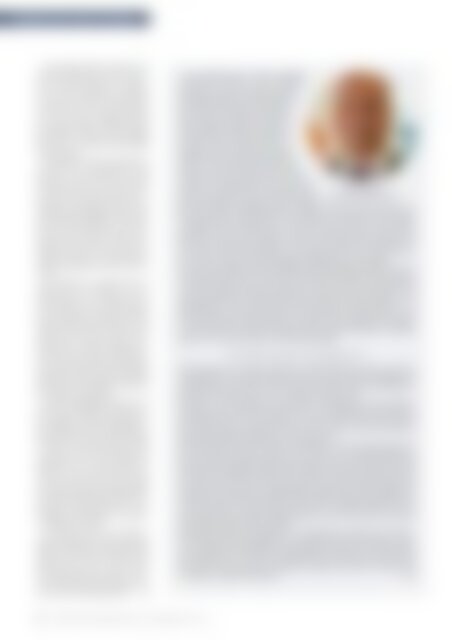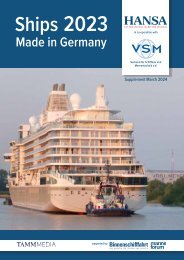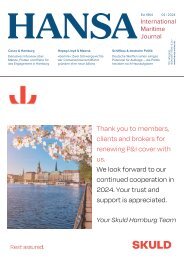HANSA 01-2019
Speditionen | Windantrieb | Tanker-Report | RAVE | Bilanz deutscher Häfen | Hyperloop | Fokus Bunker & Schmierstoffe | Shortsea | dship | Hansa Heavy Lift | Review HANSA-Forum
Speditionen | Windantrieb | Tanker-Report | RAVE | Bilanz deutscher Häfen | Hyperloop | Fokus Bunker & Schmierstoffe | Shortsea | dship | Hansa Heavy Lift | Review HANSA-Forum
Sie wollen auch ein ePaper? Erhöhen Sie die Reichweite Ihrer Titel.
YUMPU macht aus Druck-PDFs automatisch weboptimierte ePaper, die Google liebt.
Schiffstechnik | Ship Technology<br />
The challenge that lies ahead for the<br />
maritime community is that in the future<br />
it will be moving into a »multifuel<br />
era«, which will provide a challenge<br />
to all those involved in the process.<br />
Currently, there is a range of lubricant<br />
oils on the market ranging from BN<br />
25 through to BN 140, with the higher<br />
BN numbers coming into play through<br />
the discovery of cold corrosion through<br />
slow steaming.<br />
With new fuels being introduced to<br />
the market, it is expected that a BN<br />
number of around 40 will be needed<br />
for engines that run this range of fuels.<br />
For this Total Lubmarine is also developing<br />
its own lubricant that is set to<br />
also meet the challenges of the future<br />
environmental regulations. »We’ve seen<br />
that you can mess about with the standard<br />
oils on the market to make something<br />
that will work, but we have decided<br />
to develop a new lubricant that<br />
will be launched later in 2<strong>01</strong>9«, Dal Farra<br />
says.<br />
He continues to explain that although<br />
there are BN40 oils on the<br />
market, these are not right for modern<br />
combustion and a redevelopment<br />
of this oil needs to be done. Due to the<br />
range of fuels that we could see on the<br />
market in the future, another challenge<br />
will be to keep the engine clean,<br />
as these fuels are still an unknown factor<br />
for owners. The latest development<br />
from Total Lubmarine has taken things<br />
right back to the start again and additives<br />
that have detergency have now<br />
been added to the product.<br />
Dal Farra highlights that there are<br />
three main options for shipowners to<br />
be compliant in the future, blended fuels,<br />
scrubbers or LNG. He adds that Total<br />
believe that LNG will take the lead<br />
as studies are showing that this fuel<br />
is coming out the most compliant for<br />
shipowners to use. Not only that but<br />
Total have also recently signed two<br />
contracts with CMA CGM to supply<br />
its nine ultra large containerships that<br />
are under construction with LNG. Preparing<br />
for the IMO 2020 Total is also<br />
working on developing a new compliant<br />
fuel for the market.<br />
As 2020 gets close, the market is<br />
slowly taking steps to choose the right<br />
solution. Uncertainty still resides in the<br />
industry with no clear outcome until<br />
2020, where the clear winner will be<br />
the solution that works. Steps are taken<br />
by both OEM’s and shipowners to<br />
meet with the challenges ahead. n<br />
»A lot of R&D needed – Who is capable?«<br />
Shell Marine, as lubrication part of a large<br />
oil and gas company, considers itself well<br />
positioned for the future, especially in<br />
view of the new regulations around the<br />
IMO’s »Sulphur Cap 2020«. The choice<br />
of lubrication obviously depends on<br />
the fuel or the technology used, be it a<br />
scrubber, LNG or low and ultra low<br />
sulphur fuel oil. Shell believes, a significant<br />
part of the market will shift to fuels<br />
with less than 0.5% sulphur, where other<br />
cylinder oil formulations with a lower BN<br />
number is expected to deliver optimum performance.<br />
This will be a mixture of very low sulphur<br />
Joris van Brussel,<br />
General Manager Shell Marine<br />
fuel oil (VLSFO) and distillate fuel. It is expected that 30% of the market could<br />
be using scrubbers by 2025-2030, which is likely to see demand recover for higher<br />
BN lubricants, although their use may then drop off if new environmental<br />
legislation restricts use of scrubbers. However, LNG technology is taken care of,<br />
too. »We are as much a gas company as we are an oil company. So we really believe<br />
in the future of LNG and therefore we have lubricants to serve LNG driven vessels«,<br />
Joris van Brussel, General Manager of Shell Marine, tells <strong>HANSA</strong>.<br />
A major focus is placed on joint development work with engine manufacturers with<br />
tests at the Marine & Power Innovation Centre (MPIC) in Hamburg. There, Shell has<br />
a number of engines and own testing is done, before products are going into field<br />
trials. With regard to the Sulphur Cap, there is quite a lot of need for testing – even<br />
although there are not so many market-ready low sulphur fuel oils available, yet . Van<br />
Brussel thinks, on the product side, there is still insecurity: »Think about the crew<br />
on board, they have to handle these new products. They might know the engine<br />
very well, but do they know the products in the engine? Fuel quality is probably<br />
going to vary, because people are also blending things.«<br />
»We intend to partner with shipowners«<br />
With the group’s own »Miles« programme, Shell intends to do analysis and to do<br />
it much quicker. »We intend to partner not so much with the bunker suppliers but<br />
with shipowners. We want to ensure that they are able to have something that is<br />
going to work reliably for the crew«, the general manager adds.<br />
One aspect is the on-going trend towards more automation on board. Shell is<br />
working on some projects in this field. »We are using algorithms and machine<br />
learning. Still the crew and the shipowner need to be able to operate the ship, but<br />
they need the right information for that. In this respect, we do a lot of sensor<br />
testing with engine manufacturers«, van Brussel says.<br />
The post-2020 scenario poses different challenges for slow speed cylinder oils to<br />
the ones OEMs have been focusing on over recent years, where BN80-BN100 oils<br />
have been needed to defend newer engines against cold corrosion under part-load<br />
conditions burning higher sulphur fuels. 0.5% fuel use will drive demand towards<br />
lower BN oils. »The two-stroke product portfolio for 2020 is largely in place, but<br />
we expect that there will be a requirement for significant volumes of higher BN<br />
cylinder oils to be replaced by BN40 or BN70 grades«, Shell stated already. Latest<br />
work at the MPIC is focusing on the final tests of a new 40BN cylinder oil for two<br />
stroke engines that is already undergoing field trials and is expected to be available<br />
in the market in the early part of 2<strong>01</strong>9.<br />
Being asked whether the challenges for the whole industry and the need for intensive<br />
and costly research might lead to a consolidation on the lubrication market,<br />
too, van Brussel says: »The industry is full of players. In the future, we will see much<br />
more different fuels. We have the capability for the whole range of products. But<br />
that requires a lot of capacity and investment in R&D. I don’t know to what extend<br />
everybody is capable of doing that.«<br />
MM<br />
© Shell<br />
64 <strong>HANSA</strong> International Maritime Journal – 156. Jahrgang – 2<strong>01</strong>9 – Nr. 1


















